标签:hellip font const das arc 其它 运算符 总结 串处理
一、实验结论:
// 练习:使用二分查找,在一组有序元素中查找数据项 // 形参是数组,实参是数组名 #include <stdio.h> const int N=5; int binarySearch(int x[], int n, int item); int main() { int a[N]={6,16,20,52,66}; int i,index, key; printf("数组a中的数据:\n"); for(i=0;i<N;i++) printf("%d ",a[i]); printf("\n"); printf("输入待查找的数据项: "); scanf("%d", &key); // 调用函数binarySearch()在数组a中查找指定数据项item,并返回查找结果给index // 补足代码① // ××× index=binarySearch(a,N,key); if(index>=0) printf("%d在数组中,下标为%d\n", key, index); else printf("%d不在数组中\n", key); return 0; } //函数功能描述: //使用二分查找算法在数组x中查找特定值item,数组x大小为n // 如果找到,返回其下标 // 如果没找到,返回-1 int binarySearch(int x[], int n, int item) { int low, high, mid; low = 0; high = n-1; while(low <= high) { mid = (low+high)/2; if (item == x[mid]) return mid; else if(item<x[mid]) high = mid - 1; else low = mid + 1; } return -1; }
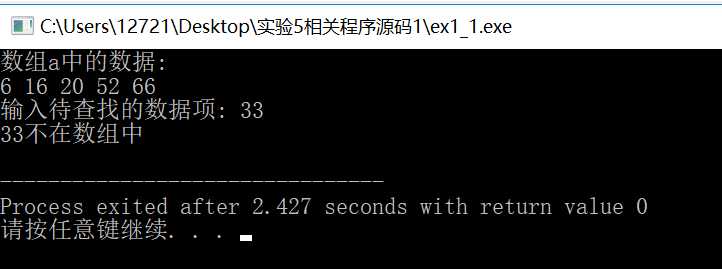
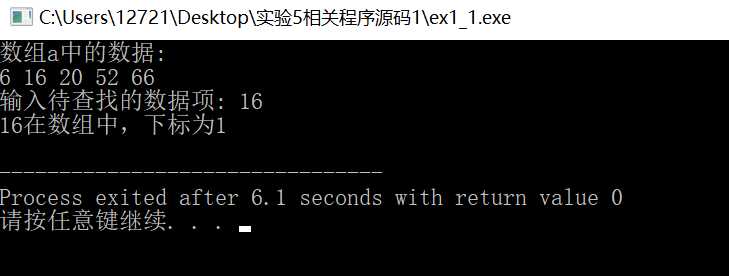
// 练习:使用二分查找,在一组有序元素中查找数据项 // 形参是指针变量,实参是数组名 #include <stdio.h> const int N=5; int binarySearch(int *x, int n, int item); int main() { int a[N]={3,4,5,15,26}; int i,index, key; printf("数组a中的数据:\n"); for(i=0;i<N;i++) printf("%d ",a[i]); printf("\n"); printf("输入待查找的数据项: "); scanf("%d", &key); // 调用函数binarySearch()在数组a中查找指定数据项item,并返回查找结果 // 补足代码① // ××× index=binarySearch(a, N, key); if(index>=0) printf("%d在数组中,下标为%d\n", key, index); else printf("%d不在数组中\n", key); return 0; } //函数功能描述: //使用二分查找算法在x指向的数据项开始的n个数据中,查找item // 如果找到,返回其位置 // 如果没找到,返回-1 int binarySearch(int *x, int n, int item) { int low, high, mid; low = 0; high = n-1; while(low <= high) { mid = (low+high)/2; if (item == *(x+mid)) return mid; else if(item < *(x+mid)) high = mid - 1; else low = mid + 1; } return -1; }
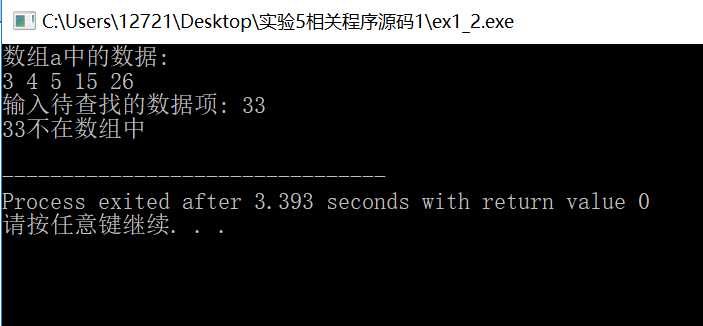
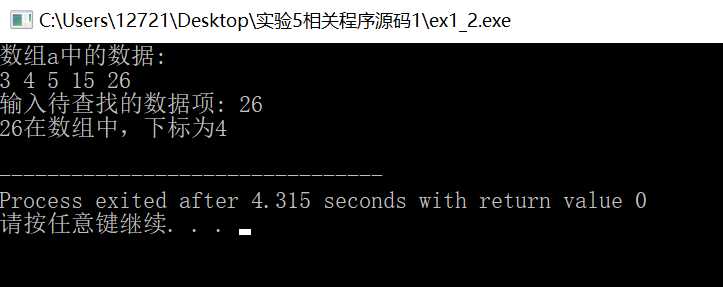
// 练习:使用选择法对字符串按字典序排序 #include <stdio.h> #include <string.h> void selectSort(char str[][20], int n ); // 函数声明,形参str是二维数组名 int main() { char name[][20] = {"Yang", "Hai", "Yi", "Huang", "Yu","Ting"}; int i; printf("输出初始名单:\n"); for(i=0; i<6; i++) printf("%s\n", name[i]); selectSort(name, 6); // 调用选择法对name数组中的字符串排序 printf("按字典序输出名单:\n"); for(i=0; i<6; i++) printf("%s\n", name[i]); return 0; } // 函数定义 // 函数功能描述:使用选择法对二维数组str中的n个字符串按字典序排序 void selectSort(char str[][20], int n) { int i,j; char t[20]; for(i=0;i<n-1;i++) { for(j=0;j<n-i-1;j++) { strcmp(str[j],str[j+1]); if(strcmp(str[j],str[j+1])>0) { strcpy(t,str[j]); strcpy(str[j],str[j+1]); strcpy(str[j+1],t); } } } }
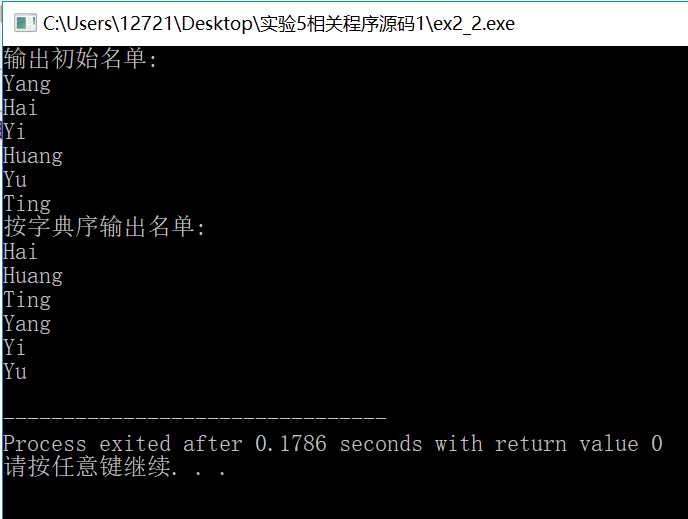
// 用指针变量处理字符串练习2 // 删除中间和末尾的* (即除了前导*,删除字符串中其它全部*) #include <stdio.h> void delStarButPrefix(char []); // 函数声明(函数声明中可以省略数组名不写) int main() { char string[80]; printf("输入一个字符串:\n"); gets(string); printf("\n删除<中间和末尾的*>之前的字符串:\n"); puts(string); delStarButPrefix(string); // 调用函数,删除中间和末尾的*; 注意实参的写法 printf("\n删除<中间和末尾的*>之后的字符串:\n"); puts(string); return 0; } // 函数定义 // 函数功能描述 // 删除字符数组s中除了前导*以外的所有*(即删除字符串中间和末尾出现的*) void delStarButPrefix(char s[]) { int i=0; // i用于记录字符在字符数组s中的下标 char *p = s; // 跳过前导*,i记录字符在字符数组s中的下标,p记录首个非*字符的位置 while(*p == ‘*‘) { //while(*p && *p == ‘*‘) 不太懂什么意思 就去掉了*p p++; i++; } // 从p指向的字符开始,把遇到的*删除 while(*p) { if(*p != ‘*‘) { s[i] = *p; i++; p++; } else p++; //开始不太懂p++不在if里面 就分开写了 } s[i] = ‘\0‘; // *p=0是就结束循环了 s[i]没有被赋结束符号 }
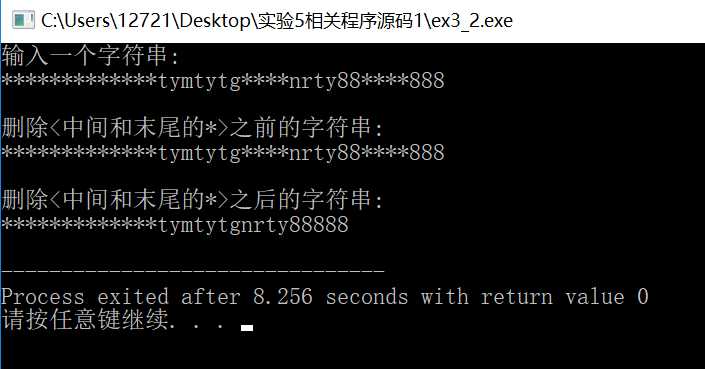
练习1、3未改动
二、实验总结:
1.数组名作为参数 vs. 指针变量作为参数在形参、实参写法
数组名作为函数参数,传递的值是地址。
case1: 实参—数组名,形参—数组名
… void f( int [] , int ); int main() { int a[5]; … f(a,5); … } void f( int x[], int n ){ … }
case2: 实参—数组名,形参——指针变量
… void f (int *, int ); int main() { int a[10]; … f(a,10); … } void f (int *p, int n ) { … }
case3: 实参—指针变量,形参—数组名
… void f( int [] , int ); int main() { int a[5], *p; p = a; … f(p,5); … } void f( int x[], int n ){ … }
case4: 实参—指针变量,形参—指针变量
… void f( int [] , int ); int main() { int a[5], *p; p = a; … f(p,5); … } void f( int *q, int n ){ … }
2.常用指针定义小结
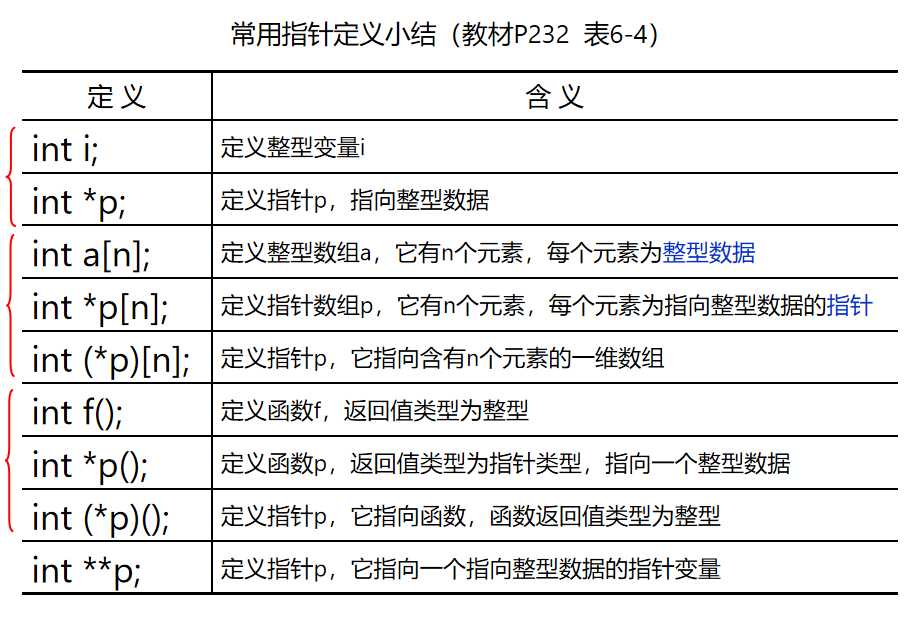
3.使用选择法对字符串排序时注意事项:
注意字符串的比较和赋值,不能直接使用关系运算符和赋值运算符,要借助字符串处理函数。
4.使用指针变量对字符串进行处理
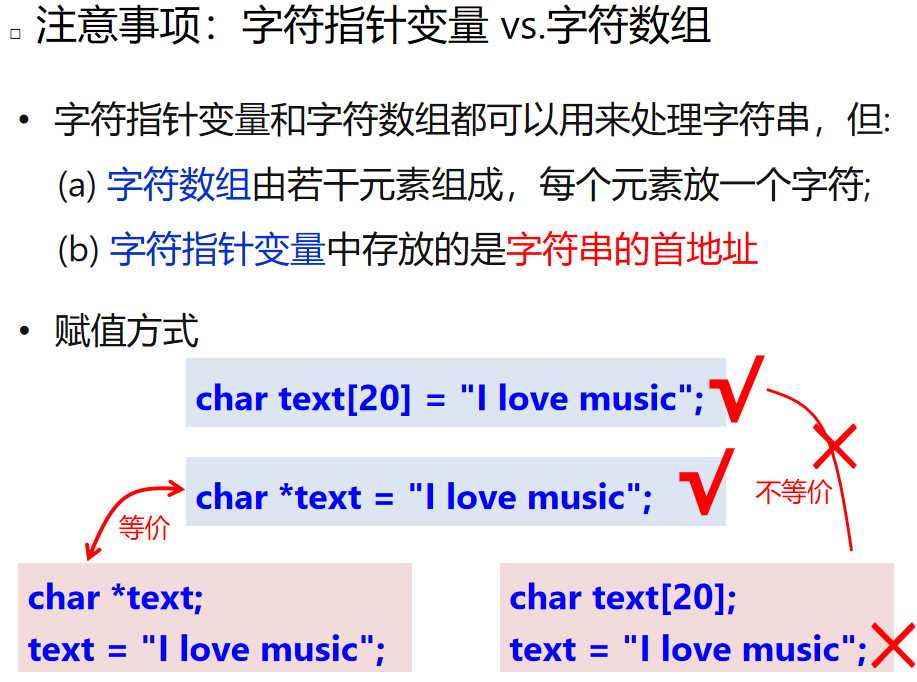
标签:hellip font const das arc 其它 运算符 总结 串处理
原文地址:https://www.cnblogs.com/xiaerhe/p/10898616.html